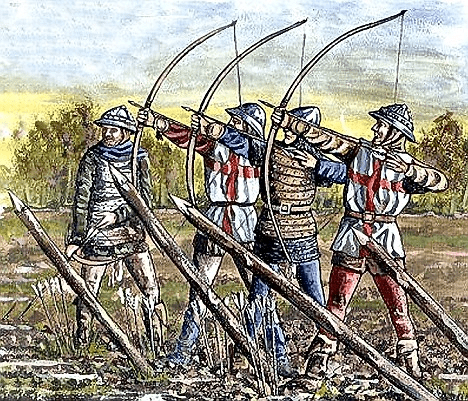On October 25, 1415, English King Henry V led his men into the battle that would give England the upper hand in the English/French conflict that would become known as the Hundred Years’ War. He was at the very center of the cavalry formation, personally pressing his men forward. His small army of skillful warriors was prepared to give everything it had to protect its king and nation’s reputation. Henry V’s dedication to his country’s image was very evident in the amount of time he put into his strategy and training for his men. As the English army advanced toward the swarming French forces, which was more than triple their size, King Henry reminded his troops to always fall back on their training and to fight until the very end. Henry V gave the army one last morale boost, reminding his men what they were doing for England, before participating in one of the most gruesome battles that the fifteenth century world had ever witnessed.1

The legendary battle ran much deeper than a simple feud or declaration of war. Instead, it was fought over King Henry V’s blood-right to rule France through his great-grandfather Edward III’s claim through his French mother, Princess Isabella. After Henry’s official accession to the throne, he inherited the entire royal army, for which he had great plans. Following his coronation, he began taking greater initiative involving foreign policy than his predecessor, and intended to take an offensive against the French. His goal was to outdo his father, and to restore England’s lost glory, which had eroded over the failed battles of 1412. His will to prove himself in battle primarily stemmed from the fact that he had many enemies within his own court. There were those who, if rumor was to be believed, were looking to overthrow him. He soon established more support within several provinces such as Guienne, making his old family friend, Earl of Dorset, the Lieutenant of Guienne, where Henry funded the training of men-at-arms and archers, which he predicted would be needed to win Agincourt. For hours, the Earl of Dorset trained the archers on their accuracy, technique, and plan of attack.2
Henry V quickly began working on improving his already impressive army, as he considered it to be the backbone of his entire authority. He strengthened his combatants by providing them with new logistics and knowledge about combat, and created entire battalions of Longbowmen to counteract France’s tendency to rely on large numbers of well-trained knights. Henry V personally appointed Longbowmen specialists to condition his Longbowmen, and devised a cunning plan to out strategize the French. Henry V was stubborn and determined to win, and he often made use of whatever cutting-edge techniques or technology that he could get his hands on. He began creating an overarching war plan: something revolutionary for the era. Most wars followed similar patterns, while Henry V came up with a whole new route to attack, and plan of attack with a new killer formation.3 He trained and prepared his troops to adapt quickly to different movements and formations, and made sure that his Longbowmen could fire on multiple groups of targets simultaneously. He did everything in his power to prepare his soldiers for war and conquest.4

In the final stage of preparation, Henry V began forcefully taking land and supplies from the French, and embarked on one of his most daring missions: sailing across the Bay of the Seine to Port Harfleur, which was very strategic positioning to begin his march to face the French. This allowed Henry the opportunity to seize supplies from the French for England’s troop’s long journey ahead.5 However, after the Siege of Harfleur earlier in 1415, Henry’s forces were unable to replenish as much of their supplies as they would have liked. Henry V’s forces and supplies were limited by the space in their boats and what they could commandeer from the French, which reversed most of Henry V’s progress, and they took more casualties when the English confronted the French for supplies. The English faced the overwhelming numbers of the French compared to Henry V’s small band of warriors left. The number of French present ranged from the thousands to the millions according to the different accounts from the time, leaving historians only able to guess the actual number of French that opposed the English. Historians now can only speculate about the true numbers. The only thing that could prevent the defeat of the English was their skill with the Longbow and the English’s formation. Henry V hoped his new strategy and weaponry would give him some means to fend off against his enemy. Henry V had a dwindling army compared to the French’s knights in armor. His soldiers were disciplined, but few. Would they be able to execute their plan of attack and withstand the French’s force?6
There was some time before the conflict commenced when the French were taunting the English to begin the battle, since they were so outnumbered. After the English advanced their forces, the French Army charged into the middle ground. A key factor that was not considered was the location of the battle and the weather leading up to it. One problem with these factors was the place where the Agincourt battle was located. It was between two tree-lines, with its fields muddied from storms from the previous night leading up to the battle. This caused it to be hard for many of the men and horses to keep their footing, making most knights dismount. Some lost their horses in the mud.

As the French continued to advance, the English longbow men fired into the mass of French soldiers. This caused some French soldiers to fall out of ranks, and others more heavily armored fell down, and others were unable to rise and drown in the growing mounds of bodies. Another advantage of the English was their ability to maneuver easily, as their gear was made up of simple leather or minimal metal armor, while the French knights had trouble crossing the mud, thanks to their full coats of armor. After the English shot all their arrows into the masses of clumsy dismounted knights and foot soldiers, the English advanced further and the longbowmen use hatchets and hand-to-hand weapons to strike down those who have not already fallen into the growing mound of bodies. When the longbowmen ran out of arrows and the French advanced, they took out their short hand weapons to bludgeon the lasting enemy who had not already retreated. As the English struggled to keep their formation, as the chaos of the battle ensued for hours, the English’s prayers were answered. The French began to retreat! This unlikely victor rose awestruck, proving that practice makes perfect and investing in the latest technology pays off. Although this battle did not give the English the strength to win the war, this victory restored the public’s view of Henry V and showed the English people that he was a great leader in that moment.7
This battle was one of the more gruesome in history, leaving many of the warriors on both sides wounded. However, this battle is still used today as an example of strategic mastermind. Military strategists from West Point still teaches these techniques today. While we have progressed past Longbows, the grit and courage of the soldiers have proven to cause more success than sheer numbers. Many use this battle as an example of when a small army with a plan and modern technology can beat a large chaotic and unorganized one. This battle also showed how the leader’s attitude must be the model for his troops. Henry’s charismatic leadership skills greatly affected the English’s victory, and this has inspired many battle tactics and mental exercises modern military use today, including the U.S.8
- Anne Curry, The Battle of Agincourt (London: Yale University Press, 2015), 196-198. ↵
- Anne Curry, The Battle of Agincourt (London: Yale University Press, 2015), 196-204. ↵
- Jan Honig, “Reappraising Late Medieval Strategy: The Example of the 1415 Agincourt Campaign,” War in History 19, no. 2 (2012): 131-132. ↵
- Jan Honig, “Reappraising Late Medieval Strategy: The Example of the 1415 Agincourt Campaign,” War in History 19, no. 2 (2012): 124-125. ↵
- John Keegan, The Face of Battle (New York: Viking Press, 1976), 81. ↵
- Anne Curry, The Battle of Agincourt (London: Yale University Press, 2015), 196-204. ↵
- Jan Honig, “Reappraising Late Medieval Strategy: The Example of the 1415 Agincourt Campaign,” War in History 19, no. 2 (2012): 131. ↵
- Jan Honig, “Reappraising Late Medieval Strategy: The Example of the 1415 Agincourt Campaign,” War in History 19, no. 2 (2012): 123-124. ↵




21 comments
Seth Roen
Though Henry V was known as the obese king who made his entire country protestant so he can marry whomever he so pleases to produce a male heir, which he did. But people rarely talked about when he was young, a handsome and brilliant man, fitting for the first Renaissance king of England. He shows that you must keep up with technology and breakthroughs because if you don’t, you fall behind.
Raul Colunga
Having seen the movie The King that was based on King Henry V’s rise to the throne and the battle of Agincourt this article was a very interesting read. Something that surprised me was how much King Henry V was involved in the strategy and planning that went into his conquest. The movie portrayed him as less involved relied heavily on his friend Guienne, so this article was a nice contrast.
Zachary Kobs
All of this advancement started as a personal goal to outdo his father and restore England’s glory. King Henry V revolutionized military strategies and influenced the ones we have today. Thankfully all of the dedication and hard work for the English Nation paid off in Victory of the battle as the French retreated, restoring the public’s view of King Henry V and allowing him to accomplish his goals.
Dylan Hydock
Organization, Planning, and moral has proved to be the leading cause to why King Henry’s a battle that mathematically was supposed to be a loss. I’m really curious what became of the rest of Henry’s battle campaign if they had to fall back to England to help his currently wounded troops. Did he have more successes in the battlefields or was this the only great victory for him?
Elizabeth Maguire
Congrats on the nomination! Before reading this article, I had never heard of the battle of Agincourt but have heard of King Henry V. The thing I found interesting was that King Henry V had the drive and compassion to make England better than how his father left it. Great job on the article.
Malik Heard
I never knew that Henry V had to fight for the throne and the article was really interesting and fun to read.This article shows that he was truly a great strategist and carefully thought out his plan to win.Even when outnumbered he came out on top because he had a brilliant mind and was a great motivator.
Cassandra Sanchez
I found it interesting to learn about how Henry V wanted to restore England’s glory and his well thought out strategies are still taught today. I also found it interesting to learn more about what may have been going on in his mind as he prepared for war and also during the war. This shows how determined kings were at this time when leading their troops into battle.
Kimberly Parker
It’s always interesting to read an article that gives glimpses of what was going on in someone’s head at the time. This article does a good job of showing how Henry V’s mindset was during battle and how he carefully thought out his battle plans against the French. He was so compassionate about making England better than how his father left it, and that is very admirable.
Pablo Ruiz
I really enjoyed this article. I did not know Henry V had to fight to prove his right to the throne. It is cool how he gained power and immediately used the army he inherited for his goal was to outdo his father, and to restore England’s lost glory. He was a smart general and set the basis for future armies.
Eliezer Leal
Great article. Its interesting to read how Henry V’s mindset was during battle, this article shows how carefully he thought out his battle plans against the French. He inspired his men to fight to the end showing just how determined he was to win his battles no matter what.